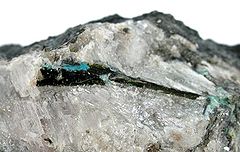- Chloroxiphite
-
Chloroxiphite 
Chloroxiphite crystal (dark green) embedded in mendipite. The bright blue material is diaboleite.General Category Halide Chemical formula Pb3CuO2Cl2(OH)2 Strunz classification 03.DB.30 Crystal symmetry 2/m - Prismatic Unit cell a = 6.6972(8) Å, b = 5.7538(5) Å, c = 10.4686(14) Å
β = 97.747(10)°Identification Color Dull olive green Crystal system Monoclinic Cleavage On {_101} perfect; {100} distinct Tenacity Very brittle Mohs scale hardness 2½ Luster Adamantine, resinous Streak Light green yellow Specific gravity 6.76 - 6.93 Optical properties Biaxial (-) Refractive index nα = 2.160 nβ = 2.240 nγ = 2.250 Birefringence δ = 0.090 Pleochroism Visible 2V angle Measured: 70° , Calculated: 36° References [1][2][3] Chloroxiphite (Greek: χλωρός, green; ζιφος, blade) is an olive green to black halide mineral sometimes found in the Mendip Hills, Somerset, England associated with mendipite. Like mendipite it is an oxychloride mineral and formed from the alteration of lead ore (galena) by a prehistoric sea.
It is rare but can be found in most of the quarries with manganese pods pyrolusite in the Mendips.[citation needed] It is found in mendipite, but it is not hard to distinguish as mendipite is white or pink. Its name comes from the Greek words meaning "green", describing its color, and "blade" as its crystal form is long blade-like crystals that often show the growth pattern and time taken to form.
References
This article about a specific halide mineral is a stub. You can help Wikipedia by expanding it.
